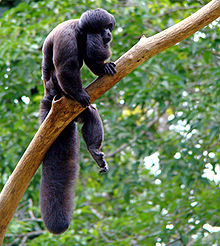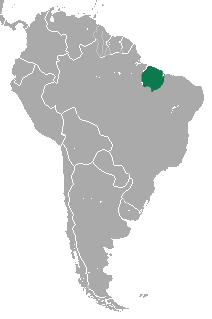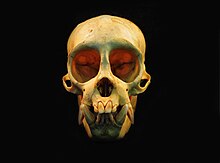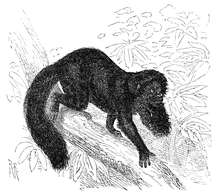User:Pithecia monachus

| Black bearded saki | |
|---|---|
| Scientific classification | |
| Domain: | Eukaryota |
| Kingdom: | Animalia |
| Phylum: | Chordata |
| Class: | Mammalia |
| Order: | Primates |
| Suborder: | Haplorhini |
| Infraorder: | Simiiformes |
| Family: | Pitheciidae |
| Genus: | Chiropotes |
| Species: | C. satanas |
| Binomial name | |
| Chiropotes satanas (Hoffmannsegg, 1807) | |
 | |
| Black bearded saki range | |

The black bearded saki (Chiropotes satanas) is a species of bearded saki, native to the Amazon rainforest in South America, specifically to an area of north-eastern Brazil[2]. Black Bearded saki are of the Platyrrhine Infraorder, also known as New World monkeys. They are from the Pitheciidae family and Chiropotes genus. This specie is one of five species of Chiropotes or bearded sakis remaining. Bearded sakis are medium-sized (50cm), mostly frugivores, specialised in seed predation [3]. The genus name Chiropotes means "hand-drinker" as they have been observed using their hands as ladles for scooping water into their mouths. This behavior is thought to be way of maintaining and protecting their magnificent beards[4]. Black bearded sakis habitat has been subdued to heavy habitat fragmentation making the future conservation status of the species unknown.[5]
Distribution and habitat
[edit]Black bearded sakis are endemic to the far eastern Amazon in Brazil, in a range restricted to a relatively small region from the Tocantins River in Pará east to around the Grajaú River in Maranhão (similar to the range of the equally threatened Kaapori capuchin). The natural home range of bearded sakis can vary from 200 to 250 ha.[6] . This is the only Amazonian pitheciidae found east of the Rio Tocantins is the Black bearded Saki[7]. Studies show that Bearded saki can adapt to reduction in habitat.
Anatomy and Morphology
[edit]
Black bearded sakis can be identified by their thick black hair, distinctive beard that shapes the face, and a bushy fox-like. Their tail is non-prehensible and use quadruple movement for locomotion.[8] Black bearded sakis have some yellowish-brown highlights around the back and shoulders and can weight from 2kg to 4 kg[5]. Sexual dimorphism results in males being slightly larger than females and also have a bulging forehead. Formerly red-backed, brown-backed and Uta Hick's bearded saki, the other member of the genus Chiropotes, where catalogued as subspecies or taxonomically insignificant variations (in which case the 'combined' species simply was called the bearded saki), but based on color of pelage, karyotype, and molecular analysis it has been recommended treating these as separate species.[9][10] The black bearded saki is the only dark-nosed species of bearded saki with a blackish back, though some females and young have a paler, brownish back.[11] Black bearded saki's teeth have evolved for seed predation: these dental adaptations allow then to crack and access seeds in extremely hard pods. They open hard-shelled fruits in a specialized, efficient process using their teeth[6].
Behavior
[edit]Diet
[edit]Black bearded sakis are highly frugivore, specialized in seed predators as 90% of their diet comes from fruits and its seeds [12]. Black bearded sakis feed mostly on plants like Sapotaceae, Lecythidaceae, and Chrysobalanaceae families but they can feed on more than 100 species as well as adapt their diets.[13] They complement their diets with fleshy fruits and small insects. Black bearded sakis can use their strong canine teeth to crack open hard shells of fruits and nuts enabling them to access the unripen seeds in the fruits.[12]
Social
[edit]They are social animals commonly grooming and playing with one another, even with those of other primate species. Black Bearded sakis can be found in troops of 20 - 30 individuals. Individuals of a troop will separate and rejoin throughout the day, have large home ranges, and travel long daily distances.[14]
Movement
[edit]Black bearded sakis spend most of time resting, traveling and eating.[5] Black bearded sakis use mostly quadruple movement to move in the canopy of trees.[8] As infants the monkeys can be seen using their tail to grasp things but lose the ability as they mature.
Mating
[edit]
Bearded sakis have a gestation period of 5 months and produce one young at a time. They don't become sexually mature until 4 years old and have an expected lifespan of 18 years.[4] Black bearded sakis give birth to offspring every 2 years.[13]
Conservation
[edit]Black bearded sakis are a critically endangered species.[15] Just over the last few decades urbanization in the Brazilian amazon has brought with it highways, agriculture, and dams creating an influx in habitat fragmentation, habitat destruction and poaching pressure.[15] Habitat fragmentation is rising as secondary roads increase and people move into uninhabited areas of the amazon rainforest. Along with an influx of people the amount of agriculture required to support the area increases, augmenting the pressure for deforestation.
Behavioral modifications due to forest fragmentation
[edit]Studies reveal that black bearded sakis can adapt to habitat up to 3% the size of their original range[13]. However, it is unclear whether this behavioral flexibility is sufficient for the long-term viability of this species in fragmented habitats[16]. Forest fragmentation has resulted in behavioral changes that allow the species to adapt but could be detrimental for the conservation statue of the species.[5] Black bearded saki groups will not leave isolated patches of fragmented forest unless the bridge of secondary forest grows[5]. Groups in smaller patches of forest will tend to move and vocalize less while resting more[5]. Population density will increase as habitat size decreases causing a positive tendency in disease among the black bearded saki population living in small patches[5]. This species also face a hunting problem for their bushmeat and their tails used as dusters.
Bearded sakis living in small forest fragments are limited in their dietary choices because of the reduced number of plant species present, and therefore consume species that those inhabiting continuous forests would ignore. Shifts in feeding patterns occur where fragmentation has been accompanied by selective logging of species used by black bearded sakis as food.[17] The ability to have a flexible diet and include seeds and unripe fruit helps this species survive in smaller forest fragments, but it appears that these conditions are unviable unless connectivity increases among the forest fragments and continuous forest in the landscape.[16] The future survival of the black bearded saki will depend on adequate meta-population and habitat management.[17] Habitat conservation is of top priority as this species has a particularly small range. The black bearded saki is considered the most endangered primate in the Amazon and is already locally extinct in a large portion of their original range.[4]
Future Survival
[edit]Studies performed at the Biological Dynamics of Forest Fragments Project study area have recorded the changes in behavior caused in black bearded sakis by habitat fragmentation. Groups of Black Bearded Saki living in 10-ha fragments of isolated rainforest showed a lack of reproduction in a period of 3.5 years[5]. This might be due to a lack of resources in these small isolated fragments of habitat. Smaller fragments of forest also result in higher population densities. The increased density of bearded saki monkeys in the small fragments may affect their health. Higher density groups living in forest fragments are often more prone to parasites and disease, than those others living in undisturbed areas[5]. It is unknown if the species will be able to reproduce and achieve healthy population in the smaller patches of fragmented forest they are force to inhabit.
| This user is a student editor in Concordia_University/GEOG_479_Primate_Behaviour,_Ecology_and_Conservation_(Winter). |
- ^ Port-Carvalho, M.; Muniz, C.C.; Fialho, M.S.; Alonso, A.C.; Jerusalinsky, L.; Veiga, L.M. (2021). "Chiropotes satanas". IUCN Red List of Threatened Species. 2021: e.T39956A191704509. doi:10.2305/IUCN.UK.2021-1.RLTS.T39956A191704509.en. Retrieved 19 November 2021.
- ^ Mammal species of the world : a taxonomic and geographic reference. Don E. Wilson, DeeAnn M. Reeder (3rd ed ed.). Baltimore: Johns Hopkins University Press. 2005. ISBN 0-8018-8221-4. OCLC 57557352.
{{cite book}}:|edition=has extra text (help)CS1 maint: others (link) - ^ Kinzey, Warren G.; Norconk, Marilyn A. (1993-04-01). "Physical and chemical properties of fruit and seeds eaten byPithecia andChiropotes in Surinam and Venezuela". International Journal of Primatology. 14 (2): 207–227. doi:10.1007/BF02192632. ISSN 1573-8604.
- ^ a b c "Bearded saki videos, photos and facts - Chiropotes satanas | Arkive". web.archive.org. 2018-04-30. Retrieved 2022-04-12.
- ^ a b c d e f g h i Boyle, Sarah Ann; Smith, Andrew T. (2009-09-12). "Behavioral modifications in northern bearded saki monkeys (Chiropotes satanas chiropotes) in forest fragments of central Amazonia". Primates. 51 (1): 43. doi:10.1007/s10329-009-0169-7. ISSN 1610-7365.
- ^ a b Van Roosmalen, Marc G. M.; Mittermeier, Russell A.; Fleagle, John G. (1988). "Diet of the northern bearded saki (Chiropotes satanas chiropotes): A neotropical seed predator". American Journal of Primatology. 14 (1): 11–35. doi:10.1002/ajp.1350140103. ISSN 0275-2565.
- ^ Ferrari, Stephen F.; Lopes, M. Aparecida (1996), Norconk, Marilyn A.; Rosenberger, Alfred L.; Garber, Paul A. (eds.), "Primate Populations in Eastern Amazonia", Adaptive Radiations of Neotropical Primates, Boston, MA: Springer US, pp. 53–67, doi:10.1007/978-1-4419-8770-9_3, ISBN 978-1-4419-8770-9, retrieved 2022-04-11
- ^ a b "Bearded saki". Wisconsin National Primate Research Center. Retrieved 2022-04-12.
- ^ "Chiropotes chiropotes: Veiga, L.M., Silva Jr., J.S., Mittermeier, R.A. & Boubli, J.-P". IUCN Red List of Threatened Species. 2008-06-30. Retrieved 2022-04-12.
- ^ Bonvicino, C.R.; Boubli, J.P.; Otazú, I.B.; Almeida, F.C.; Nascimento, F.F.; Coura, J.R.; Seuánez, H.N. (2003-11). "Morphologic, karyotypic, and molecular evidence of a new form ofChiropotes(primates, pitheciinae)". American Journal of Primatology. 61 (3): 123–133. doi:10.1002/ajp.10115. ISSN 0275-2565.
{{cite journal}}: Check date values in:|date=(help) - ^ Faria, Lucas; Nascimento, Rosemery (2019-12-01). "O FULGURITO DE SÃO GERALDO DO ARAGUAIA (ESTADO DO PARÁ)". BOLETIM DO MUSEU DE GEOCIÊNCIAS DA AMAZÔNIA. 6 (2019) (3): 1–16. doi:10.31419/issn.2594-942x.v62019i3a5ltf. ISSN 2594-942X.
- ^ a b Ayres, J. M. (1989-11-01). "Comparative feeding ecology of the Uakari and Bearded Saki, Cacajao and Chiropotes". Journal of Human Evolution. 18 (7): 697–716. doi:10.1016/0047-2484(89)90101-2. ISSN 0047-2484.
- ^ a b c Boyle, Sarah A.; Smith, Andrew T.; Spironello, Wilson R.; Zartman, Charles E. (2013). Behavioral ecology of northern bearded sakis (Chiropotes satanas chiropotes) living in forest fragments of Central Brazilian Amazonia. Cambridge University Press. ISBN 978-1-107-35468-5.
- ^ Norconk, Marilyn A.; Veres, Michael (2011-12). "Physical Properties of Fruit and Seeds Ingested by Primate Seed Predators with Emphasis on Sakis and Bearded Sakis". The Anatomical Record: Advances in Integrative Anatomy and Evolutionary Biology. 294 (12): 2092–2111. doi:10.1002/ar.21506.
{{cite journal}}: Check date values in:|date=(help) - ^ a b IUCN (2020-03-04). "Chiropotes satanas: Port-Carvalho, M., Muniz, C.C., Fialho, M.S., Alonso, A.C., Jerusalinsky, L. & Veiga, L.M.: The IUCN Red List of Threatened Species 2021: e.T39956A191704509". doi:10.2305/iucn.uk.2021-1.rlts.t39956a191704509.en.
{{cite journal}}: Cite journal requires|journal=(help) - ^ a b Boyle, Sarah A.; Zartman, Charles E.; Spironello, Wilson R.; Smith, Andrew T. (2012-09-14). "Implications of habitat fragmentation on the diet of bearded saki monkeys in central Amazonian forest". Journal of Mammalogy. 93 (4): 959–976. doi:10.1644/11-MAMM-A-286.1. ISSN 0022-2372.
- ^ a b Ferrari, Stephen F. "OCCURRENCE AND DIET OF THE BLACK BEARDED SAKI (CHIROPOTES SATANAS SATANAS) IN THE FRAGMENTED LANDSCAPE OF WESTERN MARANHÃO, BRAZIL" (PDF). Neotropical Primates. 12.1: 17–21 – via Academia.edu.
{{cite journal}}: line feed character in|title=at position 33 (help)

